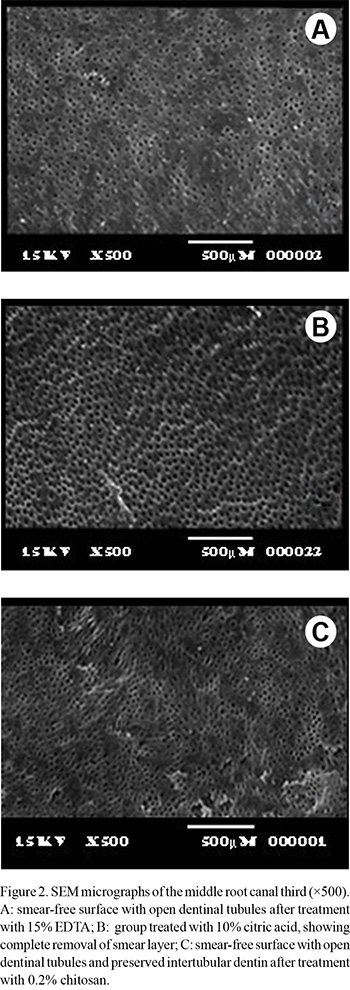The effect of solutions of 0.2% chitosan, 15% EDTA and 10% citric acid on the microhardness of root dentin was evaluated comparatively in this study. Thirteen sound human maxillary central incisors were selected and decoronated at the cementoenamel junction. Ten roots were set into rapid polymerization acrylic resin and the root/resin block was fitted to the cutting machine to obtain slices from the cervical third. The first slice was discarded and the second slice was divided into four quadrants. Each quadrant was used to construct a sample, so that 4 specimens were obtained from each root slice, being one for each chelating solution to be tested: 15% EDTA, 10% citric acid, 0.2% chitosan and distilled water (control). The specimens were exposed to 50 μL of the solution for 5 min, and then washed in distilled water. A microhardness tester (Knoop hardness) with a 10 g load was used for 15 s. Data were analyzed statistically by one-way ANOVA and Tukey-Kramer test (α=0.05). The other 3 roots had the canals instrumented and irrigated at the end of the biomechanical preparation with the test solutions, and then examined by scanning electron microscopy (SEM) for qualitative analysis. All solutions reduced the microhardness of root dentin in a way that was statistically similar to each other (p>0.05) but significantly different from the control (p>0.05). The SEM micrographs showed that the three solutions removed smear layer from the middle third of the root canal. In conclusion, 0.2% chitosan, 15% EDTA and 10% citric acid showed similar effects in reducing dentin microhardness.
microhardness; EDTA; chitosan; chelating agent


